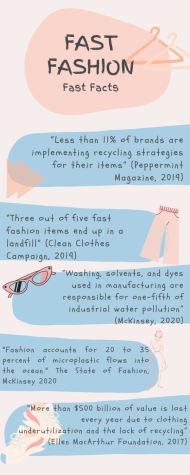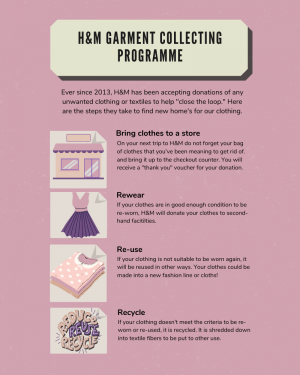Fast fashion supports trends while environment health is pushed aside
December 1, 2021
Fast fashion is something that has swallowed the fashion industry whole. While the affordability factor is appealing, the effect on the environment is undeniable. Despite the environmental risk, sometimes shopping fast fashion is unavoidable.

Fast fashion is clothing that is made quickly to match trends that is also very inexpensive to make and sell. Some stores like SHEIN and ROMWE sell their clothing at a very low price to match the low price of production. Other stores like Zara, GAP and H&M raise the prices slightly and are seen as a somewhat better option than their competitors.
Trends zip in and out of our day-to-day lives so quickly that it is hard to keep up and stay in style. These stores make staying in style more accessible to the masses.
The downside to accessibility is the detrimental effect fast fashion has on the environment. The speed at which trends come and go results in more clothes being wasted and ending up in landfills. According to the Saturday Evening Post, the average American throws away around 81 pounds of clothing yearly.
If you’re a teenager, getting an income to get new clothes is just not realistic, sometimes it’s all you can afford, and it’s an ugly truth, but most of the products we consume also have similar consequences.
— Anonymous
H&M is one of the most widely known brands for producing fast fashion clothing; however, it is also one of the biggest brands to start a public initiative for more sustainable production and sales.
H&M stated in their 2020 Sustainability Performance Report that their vision is to lead the change towards circular and climate positive fashion while being a fair and equal company. In order to achieve their vision they are moving away from a linear model of clothing production. Rather than the common take, use, waste cycle of linear models they want to move to a circular model, repair, reuse, remake and recycle.

In 2013 H&M rolled out their global Garment Collecting Programme. In order to follow the four “r’s” of the circular model they put in place, clothing and textile collecting bins were placed inside H&M retail stores. If clothes were donated to H&M the customer would receive a “thank you” voucher to use on their next purchase.
Once the clothing and textiles are collected from the boxes there are three different paths that can be taken. The first path is rewear. In this case, the clothes are in good enough condition to be donated to second-hand clothing stores.
The next path taken is reuse. When clothing is reused, it means it is not suitable for donation but it can be made into other items like remake collections. The clothing that is donated is shredded into textile fibers and goes through a long process that results in new clothing for H&M.
If the clothing cannot be reworn or reused, it is recycled. Recycling the clothing means that it will be shredded into textile fibers and put to a different use.